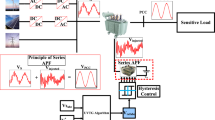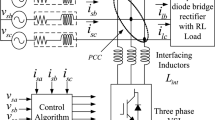Abstract
In this paper, a real-time synchronized harmonic phasor measurements-based fault location (RT-SHPM-FL) method for transmission lines is proposed. At transmission line protection center (TPC), the synchronized harmonic phasor measurements are obtained from all phasor measurement units (PMU) deployed in a power system. At each bus, the PMU estimates time-tagged 100 and 150 Hz phasors of 3-ɸ current signals in addition to fundamental phasor (50 Hz). The proposed RT-SHPM-FL method detects and locates a fault using the magnitude of 100 and 150 Hz phasors of 3-ɸ currents and equivalent harmonic phasors (EHPs), respectively. These EHPs are calculated from the magnitude of time-tagged 50, 100 and 150 Hz three-phase current phasors. For estimating the fault distance, the RT-SHPM-FL method has employed support vector regression (SVR), because of its mimicking nature, generalization and robustness. The functioning of the proposed fault location method has been validated in real-time on a scaled-down laboratory model of 400 kV extra high voltage (EHV) transmission line of 400 km long. The experimental results and discussions show that the proposed method locates transmission line faults accurately. Further, a comparative study of the proposed fault location method using SVR and adaptive neuro-fuzzy inference system has revealed that the former one is more reliable in fault location than the latter one since the error is within ± 1%.






Similar content being viewed by others

Abbreviations
- RT-SHPM-FL:
-
Real-time synchronized harmonic phasor measurements-based fault location
- LabVIEW:
-
Laboratory virtual instrument engineering workbench
- NI cRIO:
-
National instruments compact reconfigurable input/output embedded controller
- SVR-FL:
-
Support vector regression fault location
- ANN:
-
Artificial neural network
- ANFIS:
-
Adaptive neuro-fuzzy inference system
- x(t):
-
Analog voltage or current signal
- \( x\left( {n\Delta T} \right) \) :
-
Sampled version of x(t)
- \( \Delta T \) :
-
Sampling time in seconds
- T :
-
Nominal time in seconds
- f o :
-
Nominal frequency (Hz)
- N :
-
Number of samples per cycle
- n :
-
Sample number starting (0 to N − 1)
- h = 1:
-
Fundamental frequency phasor of line current
- h = 2:
-
Second-order harmonic phasor of line current
- h = 3:
-
Third-order harmonic phasor of line current
- \( \left\langle , \right\rangle \) :
-
Dot product in Rn
- C :
-
Pre-specified value
- \( \beta_{i} \) :
-
Loss functions
- \( \gamma_{i} \) :
-
Slack variables
References
Barman, S., & Roy, B. K. S. (2018). Detection and location of faults in large transmission networks using minimum number of phasor measurement units. IET Generation, Transmission and Distribution, 12(8), 1941–1950. https://doi.org/10.1049/iet-gtd.2017.1067.
Chang, C. C., & Lin, C.-J. (2011). LIBSVM: A library for support vector machines. ACM Transactions on Intelligent Systems and Technology, 2, 27:1–27:27.
Das, S., Singh, S. P., & Panigrahi, B. K. (2017). Transmission line fault detection and location using Wide Area Measurements. Electric Power Systems Research, 151, 96–105. https://doi.org/10.1016/j.epsr.2017.05.025.
Fei, C., Qi, G., & Li, C. (2018). Fault location on high voltage transmission line by applying support vector regression with fault signal amplitudes. Electric Power Systems Research, 160, 173–179.
Gao, F., Thrp, J. S., Gao, S., Pal, A., & Vance, K. A. (2015). A voltage phasor based fault-classification method for phasor measurement unit only state estimator output. Electric Power Components and Systems, 43(1), 22–31.
Gopakumar, P., Jaya Bharata Reddy, M., & Mohanta, D. K. (2015). Fault detection and localization methodology for self-healing in smart power grids incorporating phasor measurement units. Electric Power Components and Systems, 43(6), 695–710.
Hsu, C. W., & Lin, C. J. (2002). A comparison of methods for multiclass support vector machines. IEEE Transactions on Neural Networks, 13(2), 415–425.
IEEE Standard for Synchrophasor Data Transfer for Power Systems. IEEE Standard C37.118.2-2011 (revision of IEEE Std C37.118-2005), 1–53.
Jaya Bharata Reddy, M., Gopakumar, P., & Mohanta, D. K. (2016). A novel transmission line protection using DOST and SVM. International Journal on Engineering Science and Technology, 19(2), 1027–1039.
Jiang, Z., Miao, S., Xu, H., Liu, P., & Zhang, B. (2012). An effective fault location technique for transmission grids using phasor measurement units. International Journal of Electrical Power & Energy Systems, 42(1), 653–660. https://doi.org/10.1016/j.ijepes.2012.03.020.
Kang, N., Gombos, G., Mousavi, M. J., & Feng, X. (2017). A fault location algorithm for two-end series-compensated double-circuit transmission lines using the distributed parameter line model. Electric Power Components and Systems, 45(6), 615–623.
Kumar, G. R., Gafoor, S. A., & Ram, S. S. T. (2015). A transient current based double line transmission system protection using fuzzy-wavelet approach in the presence of UPFC. International Journal of Electrical Power & Energy Systems, 70, 91–98.
Mallikarjua, B., Chatterjee, D., Jaya Bharata Reddy, M., & Mohanta, D. K. (2018). Real-time wide-area disturbance monitoring and protection methodology for EHV transmission lines. INAE Letters, 3(2), 87–106. https://doi.org/10.1007/s41403-018-0038-z.
Manassero Junior, G., Santo, S. G. D., & Rojas, D. G. (2016). Fault location in series-compensated transmission lines based on heuristic method. Electric Power Systems Research, 140, 950–957. https://doi.org/10.1016/j.epsr.2016.03.049.
Meenakshi Devi, M., Geethanjali, M., & Rama Devi, A. (2018). Fault localization for transmission lines with optimal phasor measurement units. Computers and Electrical Engineering. https://doi.org/10.1016/j.compeleceng.2018.01.043.
Mousavi-Seyedi, S. S., Aminifar, F., Rezaei, M. R., & Hasani, R. (2015). Optimal fault location algorithm for series-compensated transmission lines based on PMU data. In Smart grid conference (SGC), Tehran, pp. 105–109. https://doi.org/10.1109/sgc.2015.7857418.
Pasand, M. S., & Malik, O. P. (1999). Implementation & laboratory test results of an Elman network-based transmission line directional relay. IEEE Transactions on Power Delivery, 14(3), 782–788.
Rajaraman, P., Sundaravaradan, N. A., Mallikarjuna, B., Jaya Bharata Reddy, M., & Mohanta, D. K. (2018). Robust fault analysis in transmission lines using synchrophasor measurements. Protection and Control of Modern Power Systems, 14(3), 1–13.
Roy, N., & Bhattacharya, K. (2015). Detection, classification, and estimation of fault location on an overhead transmission line using S-transform and neural network. Electric Power Components and Systems, 43(4), 461–472.
Saber, A. (2018). New fault location scheme for four-circuit untransposed transmission lines. International Journal of Electrical Power & Energy Systems, 99, 225–232. https://doi.org/10.1016/j.ijepes.2018.01.006.
Software available at http://www.csie.ntu.edu.tw/~cjlin/libsvm.
Vallapu, P. P., Moradi-Pari, E., Fallah, Y. P., & Famouri, P. (2017). Detection and location of faults in wide area systems utilizing event-based communication scheduling. In North American Power Symposium (NAPS), Morgantown, WV, pp. 1–6. https://doi.org/10.1109/naps.2017.8107396.
Vapnik, V. (1998). Statistical learning theory (p. 1998). New York: Wiley.
Vapnik, V., Golowich, S., & Smola, A. (1997). Support vector method for function approximation, regression estimation, and signal processing. Advances in Neural Information Processing Systems, 9, 281–287.
Venkatesan, R., & Balamurugan, B. (2001). A real-time hardware fault detector using an artificial neural network for distance protection. IEEE Transactions on Power Delivery, 16(1), 75–82.
Yusuff, A. A., Jimoh, A. A., & Munda, J. L. (2014). Fault location in transmission lines based on stationary wavelet transform, determinant function feature and support vector regression. Electric Power Systems Research, 110, 73–83.
Acknowledgements
The authors would like to thank the Science and Engineering Research Board (SERB), Department of Science and Technology (DST), India for financially supporting this work through the sanction order no. CRG/2018/000302 and EMR/2017/001508.
Author information
Authors and Affiliations
Corresponding author
Additional information
Publisher's Note
Springer Nature remains neutral with regard to jurisdictional claims in published maps and institutional affiliations.
Electronic supplementary material
Below is the link to the electronic supplementary material.
Rights and permissions
About this article
Cite this article
Mallikarjuna, B., Pathirikkat, G., Sinha Roy, D. et al. A Real-Time Synchronized Harmonic Phasor Measurements-Based Fault Location Method for Transmission Lines. J Control Autom Electr Syst 30, 1082–1093 (2019). https://doi.org/10.1007/s40313-019-00500-y
Received:
Revised:
Accepted:
Published:
Issue Date:
DOI: https://doi.org/10.1007/s40313-019-00500-y



